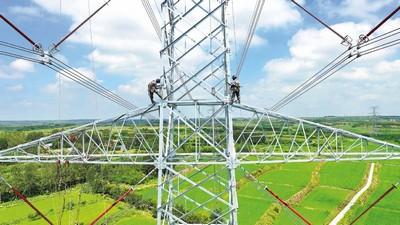
Over 1 trillion kWh of power use showcases global significance of China’s economic transition
Global Times
In July, China’s total electricity consumption surpassed the 1-trillion-kilowatt-hours mark for the first time, reaching 1.02 trillion kilowatt-hours (kWh), an increase of 8.6 percent year-on-year. Generally speaking, electricity consumption is the most direct indicator of an economy’s vitality. This is also the first time worldwide that a country’s monthly electricity use has exceeded 1 trillion kWh. On the surface, this stems from the combined effect of high temperatures and robust economic activity; at a deeper level, it reflects the powerful momentum and profound transformation of China’s high-quality economic development.
The emergence of electricity consumption on this scale is the result of the combined effects of China’s economic vitality and the resilience of its energy supply system. Electricity use is often regarded as a “barometer” of economic activity. Alongside this record-high consumption, foreign investment confidence in China’s economy has continued to rise: the International Monetary Fund raised its forecast for China’s economic growth this year by 0.8 percentage points and the Shanghai Composite Index hit a new high in nearly a decade. Behind the trillion-kWh figure also lies a major test won by China’s power infrastructure construction and supply guarantee system: Facing the extremely high loads brought by July’s hot weather, multiple forms of energy worked in coordination to maintain a stable power supply.
Looking across industries, the dual dynamics of total growth and structural optimization are particularly evident. Electricity consumption in the primary sector surged by 20.2 percent, reflecting new trends in agricultural modernization. The spread of electrified equipment, such as smart irrigation, is transforming the face of traditional agriculture. The secondary sector, the “ballast stone” of electricity consumption, also performed strongly, with electricity consumption of high-tech and equipment manufacturing seeing a significant growth rate, while electricity use in traditional high-energy-consuming industries continued to decelerate. The “one rising, one falling” trend confirms the steady advance of industrial upgrading toward greater sophistication and intelligence. In the tertiary sector, surging demand for power in internet services as well as battery charging and swapping services reflects the broad expansion of the digital economy and green transportation. Changes in electricity consumption structure are a testimony to the upgrading of industrial structure, indicating that China’s economy is moving toward a more sustainable path.
The record-breaking scale of electricity consumption in China is noteworthy for another reason: it is built upon the foundation of the green transition in energy. In July, the share of electricity generated from renewable energies rose significantly, with wind, solar and biomass power generation increasing rapidly, bringing their share close to one-quarter of the total.
According to data from the China Electricity Council, in July, electricity consumption in the four major high-energy-consuming industries (smelting and pressing of ferrous metals, manufacture of non-metallic mineral products, smelting and pressing of nonferrous metals, and manufacture of chemical materials and chemical products) grew 0.5 percent year-on-year. A US climate expert recently described the plateauing of China’s carbon emissions as “a moment of global significance,” saying, “It shows that a country can cut emissions while still growing economically.”
In 2015, China historically solved the problem of nationwide electricity access for people without power; in 2025, it became the first country in the world to achieve monthly electricity consumption of over 1 trillion kilowatt-hours. Over the past decade, China has ensured its energy security, continuously optimized its energy mix, and doubled its monthly electricity use. Now, a single month’s electricity consumption is equivalent to the entire annual electricity use of all ASEAN member states. Some institutions estimate China’s annual electricity consumption will grow 5 to 6 percent this year and exceed 13 trillion kilowatt-hours by 2030.
The sustained rise in electricity consumption continually highlights China’s unique position in the global energy and economic landscape. Power consumption data is not merely a growth curve – it is a vivid reflection of how China’s economic map is being profoundly reshaped by electrification and digitalization. The country is undergoing a leap into “high-speed electrification,” which is transforming industrial operations as well as social life. In July, urban and rural household electricity use rose 18 percent year-on-year, with provinces like Henan and Shaanxi provinces seeing increases of more than 30 percent. This surge reflects not only demand due to hot weather, but also the accelerated adoption of electrified products. Behind it lies a lifestyle transformation: air conditioners, electric vehicles, and smart home devices are becoming part of everyday life. Shenzhen is the first city in the world to have more supercharging stations than gas stations, while Hangzhou’s Cloud Manufacturing Town has successfully transformed from an electric furnace steel mill – this illustrates the deep integration of green development and smart upgrades throughout the industrial chain.
China’s leap into “high-speed electrification” carries significance far beyond its own borders, with far-reaching global implications. First, it demonstrates that a mega-economy can sustain growth while advancing a green transition, offering a real-world example for other countries exploring low-carbon development paths. Second, this massive demand is accelerating the maturity of new energy technologies and driving down costs, benefiting global markets. More importantly, China’s progress in optimizing and cleaning up its power structure is adding certainty to global climate governance and energy security. In other words, the 1 trillion kWh milestone is not only a footnote to China’s economy, but also a shared opportunity for global green transition and sustainable growth.
